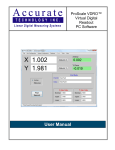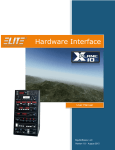Download Accurate Technology ProScale User manual
Transcript
ProScale RF Receiver User Manual Linear Digital Measuring Systems Accurate Technology, Inc. 270 Rutledge Rd. Unit E Fletcher, North Carolina 28732 828-267-0253 This document is protected by the copyright laws of the United States of America. No part of this document may be reproduced by any means, electronic or otherwise, without the expressed written permission of Accurate Technology, Inc. © 2004 Accurate Technology, Inc. Firmware Version 1.000 Attention The ProScale RF Receiver is only compatible with ProScale General Purpose Displays that are equipped with an integral RF transmitter AND firmware version 2.05 or above. ProScale RF Receiver User Manual Page 2 of 17 Table of Contents Introduction .................................................................................................. 4 Terms........................................................................................................... 5 Installation.................................................................................................... 7 Configuration................................................................................................ 7 Command Format ............................................................................. 8 Output Modes.................................................................................... 9 Deleting a previous position record ................................................... 9 Full Message Display ........................................................................ 10 Binary mode output, ProRF emulation .............................................. 10 Command Format Examples ....................................................................... 12 Position Output Examples............................................................................ 15 Defaulting the Receiver to Factory Values................................................... 17 Setting the Receiver for Master Mode on the Serial Port ............................. 17 ProScale RF Receiver User Manual Page 3 of 17 Introduction Thank you for purchasing the ProScale/ProPanel RF receiver system. This radio receiver unit is designed to be used in conjunction with Accurate Technology, Inc. ProScale™ linear measuring systems that are equipped with integral RF transmitters (display firmware version 2.05 or above). The purpose of this system is to provide a one-way wireless data communication channel between a ProScale measuring system and a computer or other computing device. Depending on the receiver model that you have purchased, the unit has the ability to receive signals from either a single ProScale display or several displays. The receiver provides RS-232 serial data in standard ASCII text format and may be configured for various output formats. In addition, the receiver will support standard baud rates from 2400 to 115200 bits per second. The following is a list of features for the ProScale RF receiver: • Six output formats to support various data collection requirements. • Programmable data field delimiter character. • Programmable line terminator. • Record start sentinel character enable/disable. • Character echo enable/disable. • Baud rate selection. • System ID selection. Prevents interference from multiple in-range systems. • Typical signal range: 50’ to 100’ depending on the environment. • Serial output transmit/receive reversal via jumper selection (null modem). Allows unit to switch from slave mode (PC use) to master mode (for use with other devices). • Receiver configuration is stored in non-volatile memory. Configuration is completed using a standard terminal program such as HyperTerminal™. ProScale RF Receiver User Manual Page 4 of 17 Terms This section provides a brief description of terms used within this manual. ASCII Text – Standard English text that is used in conjunction with computers. This can include upper and lower case letters, numbers and punctuation. Field – A field is an individual data element such as position, units or other information. Delimiter – A character that is used to separate individual fields from one another, such as a space or tab. Entry Record – A group of fields separated by delimiter characters that together form an entry in a computer file. Terminator – A special character(s) that is used to terminate an entry record. Record Start Marker – A special character that is used to indicate the start of a record being received. In this case, the marker is an asterisk (*). ProScale RF Receiver User Manual Page 5 of 17 Insert picture of front and back here. ProScale RF Receiver User Manual Page 6 of 17 Installation The ProScale RF receiver is simple to install and connect to a PC. 1. Connect the low voltage DC power supply (provided) to the rear of the receiver. Plug the power supply into an AC outlet. The top green LED on the front of the receiver will illuminate. 2. Connect the male (pin) end of the DB-9 serial cable (provided) to the rear of the receiver. Connect the female (socket) end to the PC serial port. Note: If using a newer laptop computer, there may be no RS-232 port installed on your PC. In this case, it is recommended that you purchase a USB/Serial adapter from your local office supply store. 3. Set the receiver in a location that is centrally located to receive signals from your ProScale display(s). Do not place the receiver next to large metal objects such as a filing cabinet as this may significantly reduce the receiving range. Configuration After the receiver is connected to the computer and power applied, the unit can be configured for operation. Start a terminal emulation program such as HyperTerminal™. Configure the terminal program for the serial port being used to communicate with the receiver. The following is the default port settings of the receiver: • 9600 baud • 8 data bits • No parity • 1 stop bit. • Flow Control: None Although the receiver can be configured for different baud rates, the other communications parameters are fixed and cannot be altered. When the serial port has been configured and opened, the user can test the communications by requesting the receiver’s firmware version. This is accomplished by typing the command letter v or V followed by the ENTER key. The receiver will respond with: “ProScale Receiver V1.000” or similar message. ProScale RF Receiver User Manual Page 7 of 17 Command Format The receiver uses a standard format for all configuration commands. 1. A single command letter. Lower case letters allow the current parameter state to be viewed without modification. Upper case letters allow the user to change the parameter configuration. 2. One or more parameter characters. Parameter characters are only used when modifying parameters. They have no effect when parameters are viewed (lower case command letters). The following is a list of command letters and their meanings: V – Firmware version ID. Takes no parameters. S – System ID. Used to configure the receiver to only accept signals from ProScale displays that have the same system ID programmed. Prevents other displays on other systems within radio range from being received. The default is 0. O – Output mode. Formats the record text for the desired data content. See Output Modes on page 9 for more information. The default is mode 3; position, units and display ID. D – Configures the delimiting character that is used to separate fields within a record. The default is a space. E – Enables or disables the character echo when typing in data from the terminal program. The default is ON. M – Record Start Marker. Enables or disables the use of the new record start (sentinel) character, which is an *. When enabled, each new record received starts with an asterisk (*). The default is OFF. T – Record Terminator. Each record can be terminated with either a carriage return or carriage return and line feed. The default is CR/LF. B – Baud Rate. Sets the baud rate used to communicate with the receiver. The default is 9600 bits per second. See a list of command examples beginning on page 12. ProScale RF Receiver User Manual Page 8 of 17 Output Modes There are six output modes available on the ProScale RF receiver. The first five are ASCII text formats and are outlined below: Mode 0 1 2 3 4 Description Position only Position with units type (MM or IN) Position with display (transmitter) ID Position with units and display ID Full Message Display, see next page. The fifth mode is a binary data mode that provides partial message emulation for Accurate Technology’s ProRF two-way radio system. This provides backward compatibility for applications that were designed using the ProRF system. In the case of output mode 0, an ASCII position is provided followed by the programmed terminator (CR or CR/LF). In the other text modes, each field is separated by the programmed delimiting character (space by default). The entire line or record is then followed by the programmed terminating character. The following are examples of output modes 0 through 3: Output mode 0 Position<terminator> Output mode 1 Position<delimiter>Units<terminator> Output mode 2 Position<delimiter>ID<terminator> Output mode 3 Position<delimiter>Units<delimiter>ID<terminator> Deleting a previous position record The ProScale General Purpose display has the capability of transmitting a “delete previous measurement” signal by pressing the F2 key on the display. This causes the text “DEL” to be displayed instead of a position. This can be used to indicate to manually remove the previously recorded entry in a file. ProScale RF Receiver User Manual Page 9 of 17 Full Message Display The full message display mode provides two types of messages depending on the type of signal received. • • Position Information Status Information When position information is received, the resulting message output is: Position<delimiter>Units<delimiter>ID<delimiter>Signal Strength<terminator> When status information is received, the resulting message output is: Drift status<delimiter>Battery status<delimiter>ID<delimiter>Signal Strength<terminator> The position information is similar to Output Mode 3 with the addition of a signal strength indication. Signal strength is represented by a value from 0 to 7 where 0 is a very weak signal and 7 is a very strong signal. This can be used for verifying the quality of signal reception from a particular transmitter location. The status information is used in conjunction with the drift monitor feature of the ProScale General Purpose display. If the drift monitor is enabled on the display and movement is detected outside the drift tolerance range, the display will indicate a drift condition and a drift signal will be sent on the RF channel. If a low battery condition is detected, this will also be indicated in the status information. In the case of the Full Message Display option, the “delete previous measurement” message is in the format: DEL<delimiter>ENTRY<delimiter>ID<delimiter>Signal Strength<terminator>, where DEL is substituted for the position and ENTRY is substituted for the units. Binary mode output, ProRF emulation This output mode is intended to be used with applications that were designed for the ProRF two-way radio interface system. The output from this receiver is a small subset of the functionality from the ProRF. Since the ProScale RF receiver is one-way only, no acknowledgment signal can be sent back to the display. Two different binary message packets are available from the ProScale RF receiver. One reports a combination position/status message and one reports a “delete previous record” message. Both of these message packets are ProScale RF Receiver User Manual Page 10 of 17 described below in an outline format. For detailed information regarding the ProRF communication format, review the document entitled: “ProRF System Definition and Communications Protocol Architecture” available from Accurate Technology, Inc. Measurement Sample Receiver’s Address [255] (Base) Sender’s Address [1 –254] Command Header [‘A’] Byte 1 Byte 2 Byte 3 Module Type [1] Module Status [0 – 0xFF] Encoder Status [0 – 0xFF] Byte 7 Byte 8 Byte 9 RSSI Value [‘1’ – ‘7’] 1 = low signal 7 = high signal Byte 4 Data Capture Latch [0 – 0xFF] Byte 10 Message Packet ID [0 – 255] Number of Data Bytes [13] Byte 5 Byte 6 Units of ASCII Position Operation Data [0] = mm. [‘0’ – ‘9’ ‘.’ ‘-‘] [1] = in. Byte 11 Bytes 12 - 19 Note: In the ProScale RF emulation mode, bytes 7 through 10 of the Measurement Sample message are fixed at 1, 0, 1, and 1 respectively. Delete Previous Measurement Sample Receiver’s Address [255] Sender’s Address [1-254] Command Header [‘I’] Byte 1 Byte 2 Byte 3 ProScale RF Receiver User Manual RSSI Value [‘1’ – ‘7’] 1 = low signal 7 = high signal Byte 4 Message Packet ID [0 – 255] Number of Data Bytes [0] Byte 5 Byte 6 Page 11 of 17 Command Format Examples The following examples demonstrate how to configure various parameters of the ProScale RF receiver system. <ENTER> is the enter key on the PC System To display the current system ID (from default), type in: s<ENTER> The receiver responds with: System = 0 To change the system ID to 21, type: S21<ENTER> The receiver responds with: System now = 21 Output Mode To display the current output mode (from default), type in: o<ENTER> The receiver responds with: Output Mode = 3 To change the output mode to 4, type: O4<ENTER> The receiver responds with: Output Mode now = 4 Delimiter Character To display the current delimiter character (from default), type in: d<ENTER> The receiver responds with: Delimiter = <space> To change the delimiter to a tab character, type: O<TAB><ENTER> Where <TAB> = the PC tab key. The receiver responds with: Delimiter now = <tab> ProScale RF Receiver User Manual Page 12 of 17 Echo Mode To display the current echo mode (from default), type in: e<ENTER> The receiver responds with: Echo mode on To change the echo mode to off, type: E0<ENTER> Use 0 (zero) for off and 1 for on The receiver responds with: Echo mode off Record Start Marker To display the current record start marker status (from default), type in: m<ENTER> The receiver responds with: Marker mode off To change the record start marker mode to on, type: M1<ENTER> Use 0 (zero) for off and 1 for on The receiver responds with: Marker mode on Terminator Type To display the current terminator type (from default), type in: t<ENTER> The receiver responds with: Terminator = <CR/LF> (0) To change the terminator mode to CR only (1), type: T1<ENTER> Use 0 (zero) for CR/LF and 1 for CR only The receiver responds with: Terminator now = <CR> (1) ProScale RF Receiver User Manual Page 13 of 17 Baud Rate To display the current baud rate (from default), type in: b<ENTER> The receiver responds with: Baud rate = 9600 To change the baud rate to 19200, type: B19200<ENTER> The receiver responds with: Baud rate will be = 19200 The baud rate change becomes effective 1 second after the command is issued to allow the change message to be sent at the old baud rate. Available baud rates are: • • • • • • • 2400 4800 9600 19200 38400 57600 115200 Firmware Version ID To display the current firmware version, type in: v<ENTER> or V<ENTER> The receiver responds with: ProScale Receiver V1.xxx Where xxx is the minor revision number. If an invalid command letter is entered, the receiver will provide the following response: Use t, s, o, d, v, b, m or e. Upper case to edit, lower case to view. ProScale RF Receiver User Manual Page 14 of 17 Position Output Examples All examples are terminated with carriage return/line feed (CR/LF), not shown. Output mode 0 example in inches 5.637 Output mode 0 example in millimeters 28.35 Output mode 1 example in inches with <space> delimiter 5.637 IN Output mode 1 example in millimeters with <space> delimiter 5.637 MM Output mode 2 example in inches with <space> delimiter, unit ID 3 5.637 3 Output mode 2 example in millimeters with <space> delimiter, unit ID 2 5.637 2 Output mode 3 example in inches with <space> delimiter, unit ID 3 5.637 IN 3 Output mode 3 example in millimeters with <space> delimiter, unit ID 2 5.637 MM 2 Output mode 4 example in inches with <space> delimiter, unit ID 3, signal strength 5 5.637 IN 3 5 Output mode 4 example in millimeters with <space> delimiter, unit ID 2, signal strength 7 5.637 MM 2 7 ProScale RF Receiver User Manual Page 15 of 17 Output mode 5 position packet message, position 8.537 inches from display unit ID 1, signal strength 5, message 34. Byte Number 1 2 3 4 5 6 7 8 9 10 11 12 13 14 15 16 17 18 19 Value 255 1 ‘A’ ‘5’ 34 13 1 0 1 1 1 ‘‘ ‘‘ ‘‘ ‘8’ ‘.’ ‘5’ ‘3’ ‘7’ Description Destination address (receiver) Display address ID Position command character ASCII A Signal strength ASCII 5 Message ID Number of data bytes to follow Always 1 Always 0 Always 1 Always 1 1 = inches, 0 = mm space if positive, ‘-‘ if negative hundreds digit tens digit ones digit decimal point tenths digit hundredths digit thousandths digit Output mode 5, “delete previous measurement”, from display unit ID 1, signal strength 7, message 21. Byte Number 1 2 3 4 5 6 Value 255 1 ‘I’ ‘7’ 21 0 Description Destination address (receiver) Display address ID Delete measurement command, ASCII I Signal strength ASCII 7 Message ID Number of data bytes to follow All values in binary except ASCII values where noted. ProScale RF Receiver User Manual Page 16 of 17 Defaulting the Receiver to Factory Values In the event that the user wishes to restore the receiver to factory values, complete the following: 1. Remove the four screws from the bottom of the receiver and remove the top cover. 2. Locate and press the small pushbutton on the circuit board labeled DEFAULT. 3. The AC LED will flash once to indicate that the factory parameters have been restored. 4. Replace the top cover and re-install the four bottom screws. Setting the Receiver for Master Mode on the Serial Port By default, the ProScale RF receiver is designed to operate as a slave device. In this mode, a standard serial cable is used to connect the unit to a PC for normal operation. In some cases, it may be required to use the receiver as a master device to communicate with another electronic product. To help to facilitate this, the unit’s transmit and receive pins on the DB-9 can be reversed via internal jumper settings. To reverse the transmit and receive pins, complete the following: 1. Remove the four screws from the bottom of the receiver and remove the top cover. 2. Move jumpers blocks JP3 and JP4 from pins 1 and 2 to pins 2 and 3 on each jumper. 3. Replace the top cover and re-install the four bottom screws. A male-male DB-9 serial cable may now be used or a standard male-female cable with a gender changer may be installed. ProScale RF Receiver User Manual Page 17 of 17


























